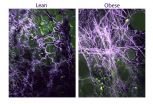Paralysis: Primates recover better than rodents
2015-08-26
(Press-News.org) Monkeys and humans exhibit greater motor recovery than rats after similar spinal cord injury, according to a study conducted in Grégoire Courtine's lab at EPFL. The study results have been published in Science Translational Medicine.
Spontaneous improvement occurs during the first six months after a spinal cord injury, allowing a hemiplegic patient to recover partial motor control. The researchers are using this observation to improve clinical trials and patient therapies. The neuronal mechanisms underlying this extensive recovery in primates are nearly absent in laboratory rats, according to the EPFL researchers.
"Research on rats is essential for developing regenerative therapies," said Dr. Courtine, "but rodents show fundamental differences from primates in terms of neuronal reorganization and functional recovery." The reason for this lies in differences in anatomy and function of the corticospinal tract, which are the fibers through which the cortex communicates with the spinal cord. In rats, the corticospinal tract is mainly located in the dorsal column and is restricted to one side of the spinal cord, whereas in monkeys and humans this pathway migrated to the lateral column, expand in size, and became bilateral.
"Because of these anatomical specificities, many fibers are spared after an injury," said Dr. Courtine. "The corticospinal tract forms detour circuits around the lesion, restoring communication between the brain and the neuronal circuits that control the movement of the arms and legs. This neuroplasticity is minimal in rats."
The more complex the movement required - such as grasping an object or walking along a horizontal ladder - the greater the differences between the two species. While rats recover the ability to walk on flat ground, they are no longer capable of picking up food or positioning their paws accurately. Monkeys and humans, on the other hand, recover fine motor control and the ability to grasp objects.
The difference is even more pronounced if the lesions are lateralized rather than symmetric, because the fibers are found on both sides of the spinal column in primates. These observations are consistent with those of more than 400 human patients with cervical lesions.
The identification of this primate-specific mechanism of recovery has major implications for future research. Using primate models rather than rat models will improve the design of therapies to repair the human spinal cord and increase the accuracy of predictive models of recovery.
INFORMATION:
This research was conducted in partnership with the California Primate Consortium led by Mark Tuszynski, the Paraplegic Center of Zurich, the University Hospital of Lausanne (CHUV) and the European Multicenter Study about Spinal Cord Injury (EMSCI) headed by Armin Curt.
ELSE PRESS RELEASES FROM THIS DATE:
2015-08-26
Scientists have developed a blood test for breast cancer able to identify which patients will suffer a relapse after treatment, months before tumours are visible on hospital scans.
The test can uncover small numbers of residual cancer cells that have resisted therapy by detecting cancer DNA in the bloodstream.
Researchers at The Institute of Cancer Research, London, and The Royal Marsden NHS Foundation Trust were able to track key mutations that cancer accumulates as it develops and spreads, without the need for invasive biopsy procedures.
They hope that by deciphering ...
2015-08-26
Using DNA sequencing, researchers have accurately painted a clear picture of fish spawning activities in a marine protected area (MPA) and have created a baseline for continuing studies on the effects of climate variability on fish populations.
A group of Scripps Institution of Oceanography at UC San Diego researchers led by Ron Burton and Alice Harada collected 260 samples off the Ellen Browning Scripps Memorial Pier over a two-year period and used DNA barcoding to accurately identify over 13,000 fish eggs.
This study was also a collaborative effort between the Scripps ...
2015-08-26
DURHAM, N.C. -- You're driving on a busy road and you intend to switch lanes when you suddenly realize that there's a car in your blind spot. You have to put a stop to your lane change -- and quickly.
A new study by Duke University researchers suggests that this type of scenario makes a person less likely to remember what halted the action -- for example, the make and model of the car in the blind spot.
People and non-human primates excel at "response inhibition." Our sophisticated brains allow us to cancel an action even when it's something engrained, like driving ...
2015-08-26
ITHACA, N.Y. - After hours harvesting forage, managing livestock and milking cows, new Cornell University agricultural economic research shows family members who work on the family dairy farm make $22,000 less annually than comparable hired managers, but are handsomely compensated with "socioemotional" wealth.
"While $22,000 seems like a large penalty, there are nonfinancial rewards they experience working for the family business," said Loren Tauer, professor at Cornell's Charles H. Dyson School of Applied Economics and Management, who with lead author Jonathan Dressler ...
2015-08-26
Compounds found in purple potatoes may help kill colon cancer stem cells and limit the spread of the cancer, according to a team of researchers.
Baked purple-fleshed potatoes suppressed the growth of colon cancer tumors in petri dishes and in mice by targeting the cancer's stem cells. Colon cancer is the second leading cause of cancer-related deaths in the U.S. and responsible for more than 50,000 deaths annually, according to the American Cancer Society.
Attacking stem cells is an effective way to counter cancer, according to Jairam K.P. Vanamala, associate professor ...
2015-08-26
ITHACA, N.Y. - Women who are obese have a higher risk and a worse prognosis for breast cancer, but the reasons why remain unclear. A Cornell study published this month in Science Translational Medicine explains how obesity changes the consistency of breast tissue in ways that are similar to tumors, thereby promoting disease.
The study of mice and women shows obesity leads to a stiffening of a meshwork of material that surrounds fat cells in the breast, called the extracellular matrix, and these biomechanical changes create the right conditions for tumor growth.
The findings ...
2015-08-26
A new study conducted by the Media Insight Project, a collaboration between the American Press Institute and The Associated Press-NORC Center for Public Affairs Research, found that while the similarities to the rest of their generation are numerous, there are some distinct differences in the way that Hispanic and African American Millennials use technology to access news and information. The source of their information is one area of difference: these young adults are more likely to use YouTube and Instagram for news than Millennials in general, though all groups rely ...
2015-08-26
Howard Hughes Medical Institute (HHMI) scientists have discovered how the most common genetic defect in amyotrophic lateral sclerosis kills nerve cells. Their study suggests that the pores that allow molecules into and out of a cell's nucleus get jammed, a finding that could speed the search for other genes that promote this fatal illness.
In people who have amyotrophic lateral sclerosis (ALS), the motor neurons that operate the muscles deteriorate. Over time, the disease deprives patients of the ability to walk, swallow, and breathe, and they usually die within three ...
2015-08-26
A study led by researchers from the U.S. Department of Energy's (DOE) SLAC National Accelerator Laboratory and the University of California, Los Angeles has demonstrated a new, efficient way to accelerate positrons, the antimatter opposites of electrons. The method may help boost the energy and shrink the size of future linear particle colliders - powerful accelerators that could be used to unravel the properties of nature's fundamental building blocks.
The scientists had previously shown that boosting the energy of charged particles by having them "surf" a wave of ionized ...
2015-08-26
They're among the most powerful tools for shedding new light on cancer growth and evolution, but mathematical models of the disease for years have faced an either/or stand off.
Though models have been developed that capture the spatial aspects of tumors, those models typically don't study genetic changes. Non-spatial models, meanwhile, more accurately portray tumors' evolution, but not their three-dimensional structure.
A collaboration between Harvard, Edinburgh, and Johns Hopkins Universities including Martin Nowak, Director of the Program for Evolutionary Dynamics ...
LAST 30 PRESS RELEASES:
[Press-News.org] Paralysis: Primates recover better than rodents

